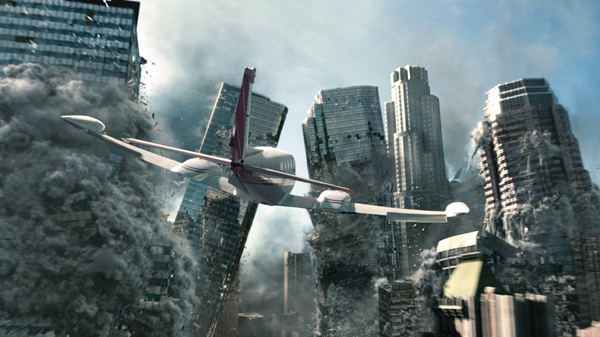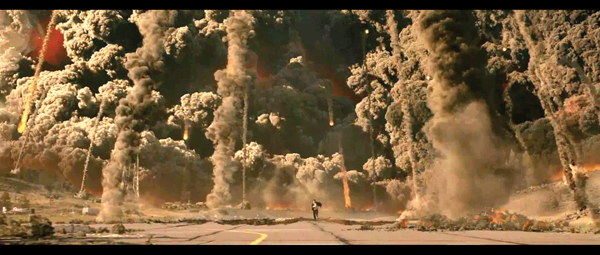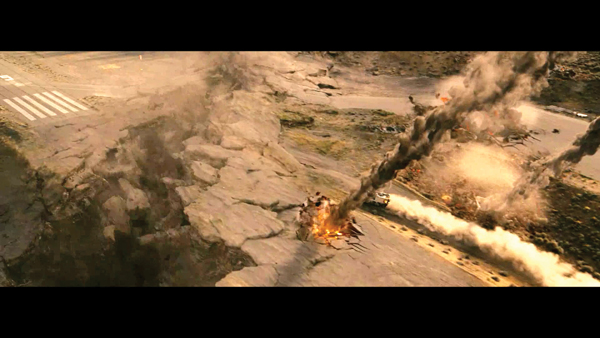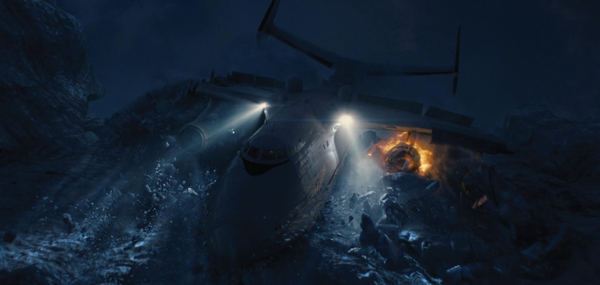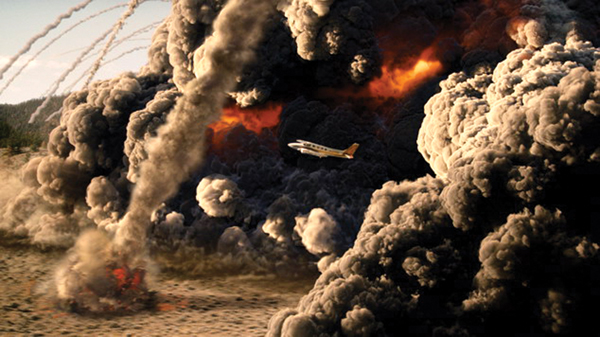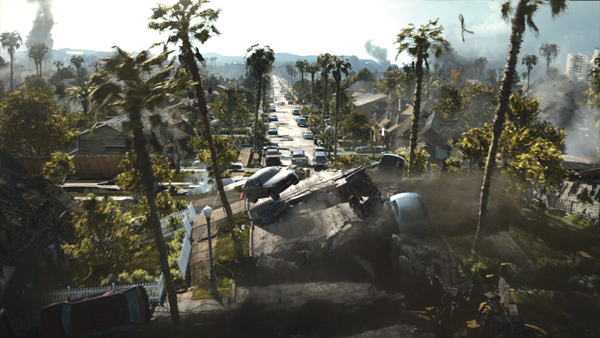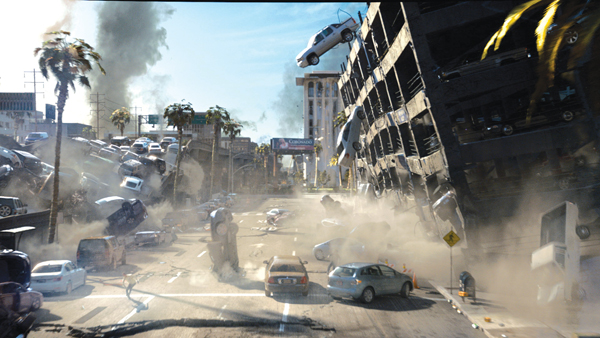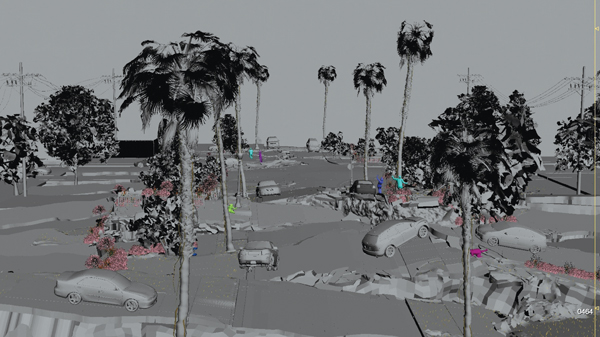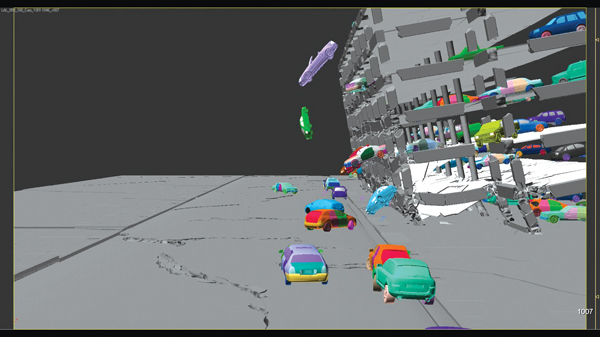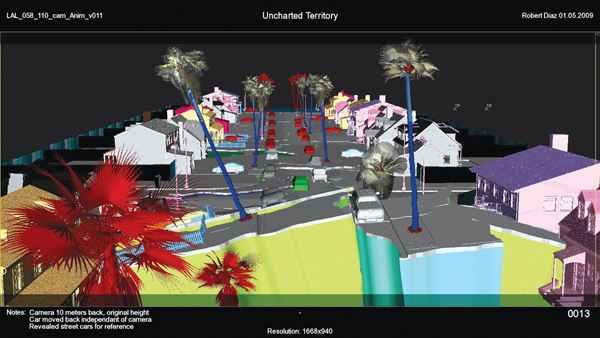Previs has always been an important filmmaking stage for Marc Weigert since one of his first major features in 1995, ‘Independence Day’. Previs technology and techniques were not as sophisticated as they are now, but he recognised its value in making sure that everyone on the project shares the same vision as the director. “Just talking around a table isn’t enough,” he said.
“During preproduction it helps coordinate the departments - stunts, special effects, visual effects - and later on set it shows actors performing on blue screen what they are aiming to portray.” Even when he and Volker, both of independent film production company Uncharted Territory and also co-producers on ‘2012’, were making a small-budget adventure movie ‘Coronado’ in 2001, they completed extensive previsualisation of the whole film. They were using 3ds Max, as now, and made sample composites with After Effects, Nuke or Fusion.
Challenging Script
As soon as they read the script of ‘2012’, Marc and Volker knew they would need comprehensive previsualistion. Furthermore, Roland Emmerich’s expectations were “larger than life”. “The script devoted only two or three sentences, for example, to a sequence depicting an earthquake chasing a limousine through downtown Los Angeles,” said Marc, “but Roland wanted to expand on it.
“We developed it through previs. First a small in-house team at Uncharted Territory developed rough animations based on the major ‘beats’ of the sequence that Roland and Writer/Producer Harald Kloser wanted to see on screen – pipes breaking, debris hitting the windscreen, the freeway crumbling, a tanker crashing down and colliding with a petrol station. These were handed off to VFX company Pixomondo to refine into a precise blueprint of all the action you see in the finished movie.”
Reality Check
They took a creative approach to collecting reference for the movie’s unprecedented geological events. Apart from researching books and the internet, on Youtube they found a Japanese company experimenting with earthquake proof buildings had built a 1:1 scale 5-story structure on a quake simulation platform and filmed its behaviour. “But we had to remember that Roland is a cinematic director, not a documentary maker, and allows enough freedom to make a scene exciting.
“A VFX artist then has to decide how far to deviate from the computer’s ability to accurately simulate reality from real-world specs – real but not necessarily cinematic or thrilling. ‘Reality’ may be too slow, or that limousine may have simply been squashed immediately, whereas with CG, it gets to run an expertly timed, choreographed, hand-animated race through LA, believable if not totally real,” Marc said.
“In order to convey the details of the story, the groundwork for this choreography is laid in previs, and once the director ‘falls in love’ with it, it’s up to you to make it happen. It can be a tempting to make allowances for the rough design of a previsualised scene, and assume it will just work out, but you may find it starts to change the flow of the story, the cut and edit. In ‘2012’, however, Pixomondo’s previs could be followed very closely.”
Staging the Story
Pixomondo’s work on the film started with previs of the destruction of St Peter’s Square. The first passes of their previs of the scene were shown to VFX Supervisors and co-producers, Volker and Marc. After their initial comments had been addressed, the passes were shown to Roland.
“Our first priority was to lock down the staging of the storytelling elements, the timing, the framing, and anything relevant for the edit of the sequence,” said Rainer Gombos, VFX Supervisor at Pixomondo. “Our goal was to deliver working sequences to the filmmakers rather than individual shots.
“The St Peter’s Square sequence had been storyboarded for us, and most of the more extensive sequences that we later worked on either had storyboards prepared or were already partially pre-visualised by other vendors. We were asked to address outstanding comments on these and to enhance the animation and look of the shots. But on some sequences we were free to suggest completely new shots.”
When Rainer and his team started working on the approximately 200 shots of the third act, the sequence was not fully storyboarded yet and they had to rely on the script as a starting point. Roland was already shooting in Vancouver at the time. “I flew to Vancouver for a few meetings and we worked out the remaining shots. He is artistic and was able to sketch out many of the remaining shots for us. Nevertheless, we also hired a storyboard artist to support our pre-visualisation team in LA.”
Antonov Crash Landing
Pixomondo’s scope of work grew and developed a great deal as the project got underway. Originally, they worked on two previs sequences. “Then for one of these, we were asked to produce finished VFX shots. We delivered around 100 final composites of full CG environments, with the Antonov cargo plane crash landing in the Himalayas and the full CG shots of helicopters transporting animals,” said Rainer.
Three VFX-heavy sequences were added to the original work assignment for previs as well - the Los Angeles limousine sequence, the Los Angeles plane sequence, the destruction of the Washington Monument and most of the third act, including all the ark boarding scenes and the scenes with the arks in the tidal wave up to when the ark is passing Mount Everest.
Thinking Particles
For their shot production, they worked with a beta version of thinking particles. “For our CG FX department in Berlin, it was enormously helpful when working on the complex CG destruction simulation. One of the most challenging shots was when the Antonov transport plane tips over at the edge of a glacier cliff. The camera is held close on the plane and the cliff, and the shot is 100% CG,” Rainer explained.
“The technical challenge was the multi-level breaking of large ice chunks into smaller and smaller pieces. All this integrated with fluid systems for smoke and icy water spray, as well as an avalanche of ice with larger chunks sliding down and disintegrating in a flood of small pieces. But the shot production did not produce major surprises, as the previs was solid. There are always changes in post production but they weren’t excessive in this case.”
Previs Pipeline
Pixomondo’s regular previsualisation pipeline is based on 3ds Max as their set-up and lighting tool, and V-Ray is used as their standard renderer. “On ‘2012’, the transition of focus from pre-visualisation to post-visualisation, to layout animation and then to final shot production was fluid, as we could stay with Max and V-Ray. After Effects was used for pre-visualisation compositing, but for final shot production our compositing department used Nuke.
“Several Pixomondo Studios contributed to the work on ‘2012’. In our LA studio, around 40 artists worked on pre-visualisation, animation, lighting and compositing. Artists working in our studio in Stuttgart contributed the Antonov textures. A team in our Frankfurt Office worked on the animals. And our CG FX team in the Berlin office, together with their compositing department, worked on the most challenging simulation shots,” Rainer said.
From May through October 2008, around 80 artists were involved overall in the production of the approximately 700 pre-visualisation and 100 VFX shots. Rainer’s team included lead animator Paul Dennis Taylor, VFX lead Mohsen Mousavi, visual effects producer Steve Kullback and VFX executive producer Thilo Kuther. They were working on previs for five months, and their final shot production assignment lasted another six months.
Earthquake Engine
As one of Pixomondo's specialties, the studio has established an effective approach to VFX previs projects. “In general, we want to deliver to the client advanced camera moves and animation. The sets might be scarcely decorated but the camera moves and the edit need to be working,” said Rainer. “The difference on ‘2012’ was that we went further in visualising CG FX elements - destruction, fire, smoke - and also delivered first lighting and matte painting passes. Many assets, models and simulations had to be produced.
“To previsualise the destruction of LA in the earthquake, we created an ‘earthquake engine’ that would slice and deform the surface depending on the amount of destruction the director asked for. We also created sets of pre-simulated house destructions that could be placed and timed according to the needs of a particular shot.” All these tools had to allow for fast iterations so they could try out and suggest alternative camera angles within the tight previsualisation schedule.
They aimed to design each shot to allow the viewer to understand it, and used whatever technique seemed the most appropriate. For example, if a car is sliding through a snow cloud at night, the headlights in the snow become an important storytelling element. Rainer said, “Every shot has a purpose and it needs to be clear, even in the previs, what the shot is about. One of our goals is to eliminate costly shots that are not needed to tell the story.”
Unreliable Humans
To a large degree, Pixomondo’s previs designs were successfully translated into layouts and used in the finished film. The sequences of the limousine driving through Los Angeles, the one with the plane taking off, then dodging collapsing skyscrapers and their completed CG sequence showing the Antonov cargo plane attempting to crash land in the Himalayas, did not change significantly in final shot production. Rainer believes that the reason for this success was that the director and the editorial department worked extensively with the team during their design.
“Fortunately, Roland Emmerich understands previsualisation,” explained Rainer, “and in most cases if he liked the previs shot, he would also approve a similar looking final composite.” There was, of course, one factor that Pixomondo couldn’t predict and control so well. “We also prevised many shots that featured actor stand-ins. In the previs, everyone accepted that the characters would stiffly slide over the floor. On the set, unfortunately, they would behave more like human beings and be terribly unpredictable, and therefore change the timing and framing of a shot. Often, the whole edit had to be changed.”
Overall, however, the previs allowed VFX production to be more predictable and there were many requests from the director or the editorial in the post-production to “make it look more like the previsualisation”.
Improving on Reality
Marc and Volker constantly had to ask themselves which story elements were possible to achieve as practical effects. Marc said, “The twin mitigating factors were time – we had only 16 months to complete – and budget. Something might be possible, but the desired choreography may take days to achieve. Each shooting day was very costly and once the scene is shot, you’re stuck with it. The same problem applies to miniatures.” With limited time and funds for experimentation, the physical reality frequently worked against them.
“Computer animation helped us particularly with such effects as the fireballs falling on Yellowstone National Park during the eruption”, said Marc. “Trying to scale up practical exploding props was never going to match Roland’s monumental visions of this scene. Likewise, putting a believable trajectory on a vehicle falling from a roof was tricky. It could neither appear to have been shot from a cannon, nor dropped from a crane.”
One of their best developments was their shaking floor for earthquakes, a 60’ by 100’ platform with dozens of computer-controlled hydraulic lifts underneath creating a wavelike motion like an ocean surface. Roland didn’t want the actors trying to pantomime the quake experience. The floor was also effective because any props placed on it with the actors would move in synch. The limousine was shot on such a floor as well. They FX team did have a few camera tracking problems matching their computer–animated floor and props to precisely match the real scene.
Genesis Footage
Marc and Volker had definitely wanted ‘2012’ to be shot digitally and were pleased with DP Dean Semler’s choice of the Genesis camera. Semler has shot several previous features digitally including ‘Apocalypto’. Marc had been working on digital movies since ‘Coronado’, started at the end of 2000, shooting on the 4:2:2 Sony F900. It was a great experience for them, despite the initial learning curve. “Having the footage immediately retrievable for effects was fantastic without having to go through the whole process of off-line edit, scanning, extracting key codes, pulling and scanning a negative, renaming files – and finally starting two days later.
“We’ve now built a 400TB server for all footage and digitise every frame shot at full resolution. An automated system uses lines from the EDL to pull the frames, moves them to our network, renames them for FX work and notifies me by email – in two minutes.”
Team Work
Throughout his discussion of ‘2012’, Marc referred to his role as a chance to learn about the possibilities for effects work to expand beyond its current form, and about how other VFX teams run their pipelines and workflow. In-house, the Uncharted Territory team completed two major sequences alongside 14 other VFX houses from Digital Domain down to small specialist companies. Between them, Marc and Volker visited all the vendors regularly, watching every step of every process and every frame of footage. He thought about what worked, what didn’t.
The next time he works on such a large project as this, he’d like to promote a more flexible pipeline composed of smaller teams. “I’d never led such a large team before and found that the traditional fragmented approach in which each person has a tiny isolated role can prevent artists from taking full responsibility for work and showing initiative, he said. “I’d rather assign smaller teams of ten or so people to work on sections of longer sequences, each taking ownership of all aspects of their section until it is finished. That way you get a more coherent, better quality result.”
|

